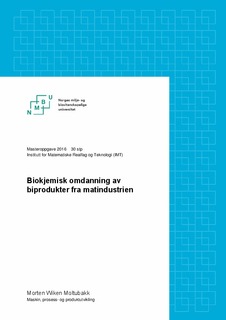| dc.contributor.advisor | Lekang, Odd Ivar | |
| dc.contributor.author | Moltubakk, Morten Wiken | |
| dc.date.accessioned | 2016-08-30T11:05:08Z | |
| dc.date.available | 2016-08-30T11:05:08Z | |
| dc.date.issued | 2016-08-30 | |
| dc.identifier.uri | http://hdl.handle.net/11250/2402750 | |
| dc.description.abstract | I denne masteroppgaven er det presentert et prosessanlegg som tar imot 3 400 kg fett, fra
slaktedyr, i timen som råstoff. Formålet med anlegget er å gjøre dette råstoffet om til frie
fettsyrer, for deretter å skille de mettede og umettede fettsyrene fra hverandre. Et utvalg
komponenter blir gjennomgått for de viktigste prosessene før de som blir sett på som best egnet
velges. På forhånd var det bestemt at anlegget skulle bruke hydrolyse med en syrekatalysator
for å splitte glyserolen og fettsyrene, og en form for destillering skulle brukes for å skille
mettede og umettede fettsyrer. Videre ble en beregning av masse- og energibalanse gjort
gjennom hele anlegget som skal gå 24 timer i døgnet, 365 dager i året.
Hydrolysemetoden som er valgt er en kontinuerlig motstrøms autoklav som er basert på et
patent av Victor Mills. For destillering av frie fettsyrer brukes flash destillasjon over tre trinn.
Beregningen av massebalansene viser at anlegget produserer 1 442,3 kg mettede frie
fettsyrer og 1 587,1 kg umettede frie fettsyrer i timen og resten går ut som glyserol og
uhydrolysert fett. Dette gir dermed et utbytte på 89 % med tanke på andel ut i forhold andel inn.
Den beregnede energibalansen viser at anlegget årlig vil ha et energiforbruk på 754,8 MWh. | nb_NO |
| dc.description.abstract | In this master thesis, a processing plant capable of handling 3 400 kg of fat from slaughtered
animals an hour is presented. The aim is to process the raw material into free fatty acids before
separating between saturated and unsaturated fatty acids from each other. A selection of
components is presented for the most important processes before the most suitable component
is chosen. It’s decided in advance that the plant will use hydrolysis with an acidic catalyst to
split the glycerol from the fatty acids, and that distillation will be used to separate the saturated
and unsaturated fatty acids. Furthermore, a complete calculation of the plants mass- and energy
balance was made with the consideration of continuous operation, running 24 hours a day, 365
days a year.
The hydrolysis method chosen is a continuous countercurrent autoclave, based on a patent
made by Victor Mills. To distil the free fatty acids a flash distillation working over three steps
is used.
The calculation of the mass balances of the plant gives a resulting flow rate of 1 442,3 kg of
saturated fatty acids and 1 587,1 kg of unsaturated fatty acids per hour. This means that the
plant has a yield of 89 % when comparing the amount withdrawn free fatty acid with the amount
of fat added.
The calculated energy balance is showing that the yearly energy consumption of the plant is
754,8 MWh. | nb_NO |
| dc.language.iso | nob | nb_NO |
| dc.publisher | Norwegian University of Life Sciences, Ås | |
| dc.rights | Navngivelse 3.0 Norge | * |
| dc.rights.uri | http://creativecommons.org/licenses/by/3.0/no/ | * |
| dc.subject | Dyrefett | nb_NO |
| dc.subject | Hydrolyse | nb_NO |
| dc.subject | Destillasjon | nb_NO |
| dc.title | Biokjemisk omdanning av biprodukter fra matindustrien | nb_NO |
| dc.type | Master thesis | nb_NO |
| dc.subject.nsi | VDP::Mathematics and natural science: 400 | nb_NO |
| dc.source.pagenumber | 82 | nb_NO |
| dc.description.localcode | M-MPP | nb_NO |

